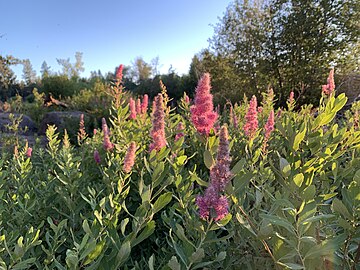
Spiraea, sometimes spelled spirea in common names, and commonly known as meadowsweets or steeplebushes, is a genus of about 80 to 100 species of shrubs in the family Rosaceae. They are native to the temperate Northern Hemisphere, with the greatest diversity in eastern Asia.
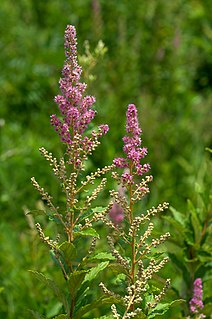
Spiraea tomentosa, commonly known as steeplebush, meadowsweet, or hardhack, or eastern hardhack, is a flowering plant native to the eastern United States and Canada.
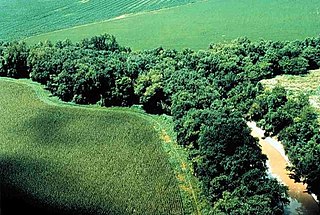
A riparian zone or riparian area is the interface between land and a river or stream. Riparian is also the proper nomenclature for one of the terrestrial biomes of the Earth. Plant habitats and communities along the river margins and banks are called riparian vegetation, characterized by hydrophilic plants. Riparian zones are important in ecology, environmental resource management, and civil engineering because of their role in soil conservation, their habitat biodiversity, and the influence they have on fauna and aquatic ecosystems, including grasslands, woodlands, wetlands, or even non-vegetative areas. In some regions, the terms riparian woodland, riparian forest, riparian buffer zone,riparian corridor, and riparian strip are used to characterize a riparian zone. The word riparian is derived from Latin ripa, meaning "river bank".
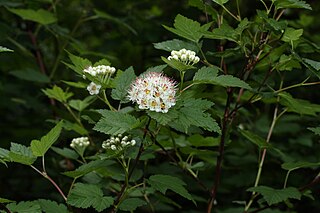
Physocarpus capitatus, commonly called Pacific ninebark or tall ninebark, is a species of Physocarpus in the rose family native to western North America.
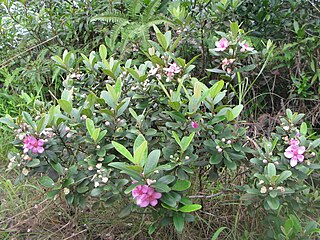
Rhodomyrtus tomentosa also known as rose myrtle, is a flowering plant in the family Myrtaceae, native to southern and southeastern Asia, from India, east to southern China, Hong Kong, Taiwan and the Philippines, and south to Malaysia and Sulawesi. It grows in coasts, natural forest, riparian zones, wetlands, moist and wet forests, bog margins, from sea level up to 2400 m elevation.

Rosa nutkana, the Nootka rose, bristly rose, or wild rose is a 0.6–3.0-metre-tall (2–10-foot) perennial shrub in the rose family (Rosaceae).

Spiraea japonica, the Japanese meadowsweet or Japanese spiraea, is a plant in the family Rosaceae.

Equisetum hyemale is a perennial herbaceous vascular plant in the horsetail family Equisetaceae. It is a native plant throughout the Holarctic Kingdom, found in North America, Europe, and northern Asia.

Carex douglasii is a species of sedge known by the common name Douglas' sedge.
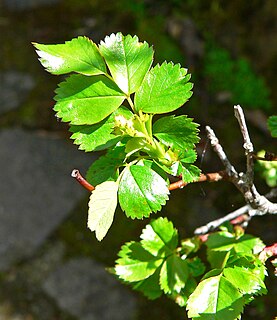
Rosa pisocarpa is a species of rose known by the common name cluster rose or swamp rose. It is native to western North America from British Columbia to northern California, where it generally grows in moist habitats. It is a shrub sometimes forming a thicket, and growing up to 2.5 meters tall. The stems can be dark red or blackish and are often studded with straight, paired prickles at nodes. The leaves are each made up of several toothed oval leaflets, the terminal leaflet up to 4 centimeters long. The inflorescence is a cyme of up to 10 flowers with pink petals each up to 2 centimeters in length. The fruit is a rose hip about a centimeter wide. The hips are pear- or egg-shaped and borne in clusters, and are decorative in fall and early winter, when they are red or reddish-purple and contrast with yellow foliage. Fall foliage can be yellow or dark red.

Tripidium ravennae, synonym Saccharum ravennae, with the common names ravennagrass and elephant grass, is a species of grass in the genus Tripidium. It is native to southern Europe, western Asia and South Asia and is known in North America as an introduced species, where it is sometimes an invasive and troublesome noxious weed.

Symphoricarpos albus is a species of flowering plant in the honeysuckle family known by the common name common snowberry. It is native to North America, where it occurs across much of Canada and the northern and western United States.
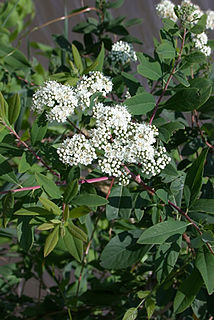
Spiraea virginiana is a rare species of flowering plant in the rose family (Rosaceae) known by the common names Virginia meadowsweet and Virginia spiraea. It is native to the southern Appalachian Mountains, where it has a distribution scattered across nine states. However, most populations are very small and poor in quality. It is threatened by disturbances in the hydrology of its habitat, introduced species of plants, and other threats. It is a federally listed threatened species of the United States.

Panicum hemitomon is a species of grass known by the common name maidencane. It is native to North America, where it occurs along the southeastern coastline from New Jersey to Texas. It is also present in South America.

Physocarpus malvaceus is a species of flowering plant in the rose family known by the common name mallow ninebark. It is native to western North America, where its distribution extends from British Columbia to Nevada to Wyoming.
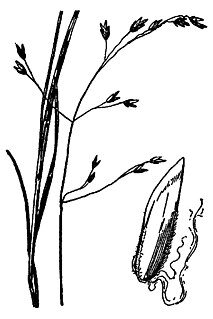
Poa paludigena is a species of grass known by the common names bog bluegrass, marsh bluegrass, slender marsh bluegrass, and Patterson's bluegrass. It is native to the northeastern United States.
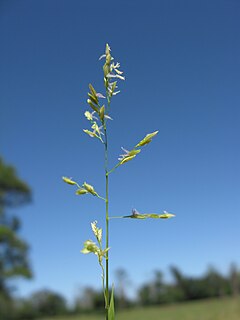
Leersia hexandra is a species of grass known by the common names southern cutgrass, clubhead cutgrass, and swamp rice grass. It has a pantropical distribution. It is also an introduced species in many regions, sometimes becoming invasive, and it is an agricultural weed of various crops, especially rice. It is also cultivated as a forage for livestock.
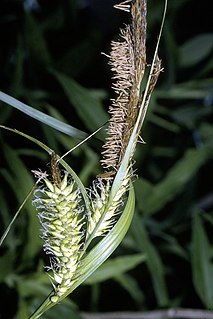
Carex lacustris, known as lake sedge, is a tufted grass-like perennial of the sedge family (Cyperaceae), native to southern Canada and the northern United States. C. lacustris us an herbaceous surface-piercing plant that grows in water up to 50 cm (1.6 ft) deep, and grows 50–150 cm (1.6–4.9 ft) tall. It grows well in marshes and swampy woods of the boreal forest, along river and lake shores, in ditches, marshes, swamps, and other wetland habitat. It grows on muck, sedge peat, wet sand or silt, in filtered or full sunlight.
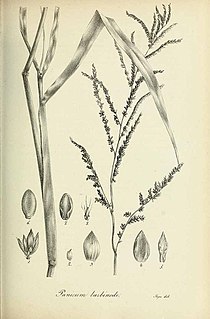
Brachiaria mutica is a species of grass known by the common names para grass, buffalo grass, Mauritius signal grass, pasto pare, malojilla, gramalote, parana, Carib grass, and Scotch grass. Despite its common name California grass, it does not occur in California; it is native to northern and central Africa and parts of the Middle East, where it is cultivated for fodder. It was introduced elsewhere and it is now cultivated throughout tropical regions of the world for this purpose.

Triadenum fraseri known as bog St. John's wort, Fraser's St. John's wort, and Fraser's marsh St. John's wort, is a perennial flowering plant in the family Hypericaceae that is grows in wetlands of the northeastern and northcentral United States and lower Canada. It is named after John Fraser (1750–1811), a Scottish botanist and widely travelled plant collector.


